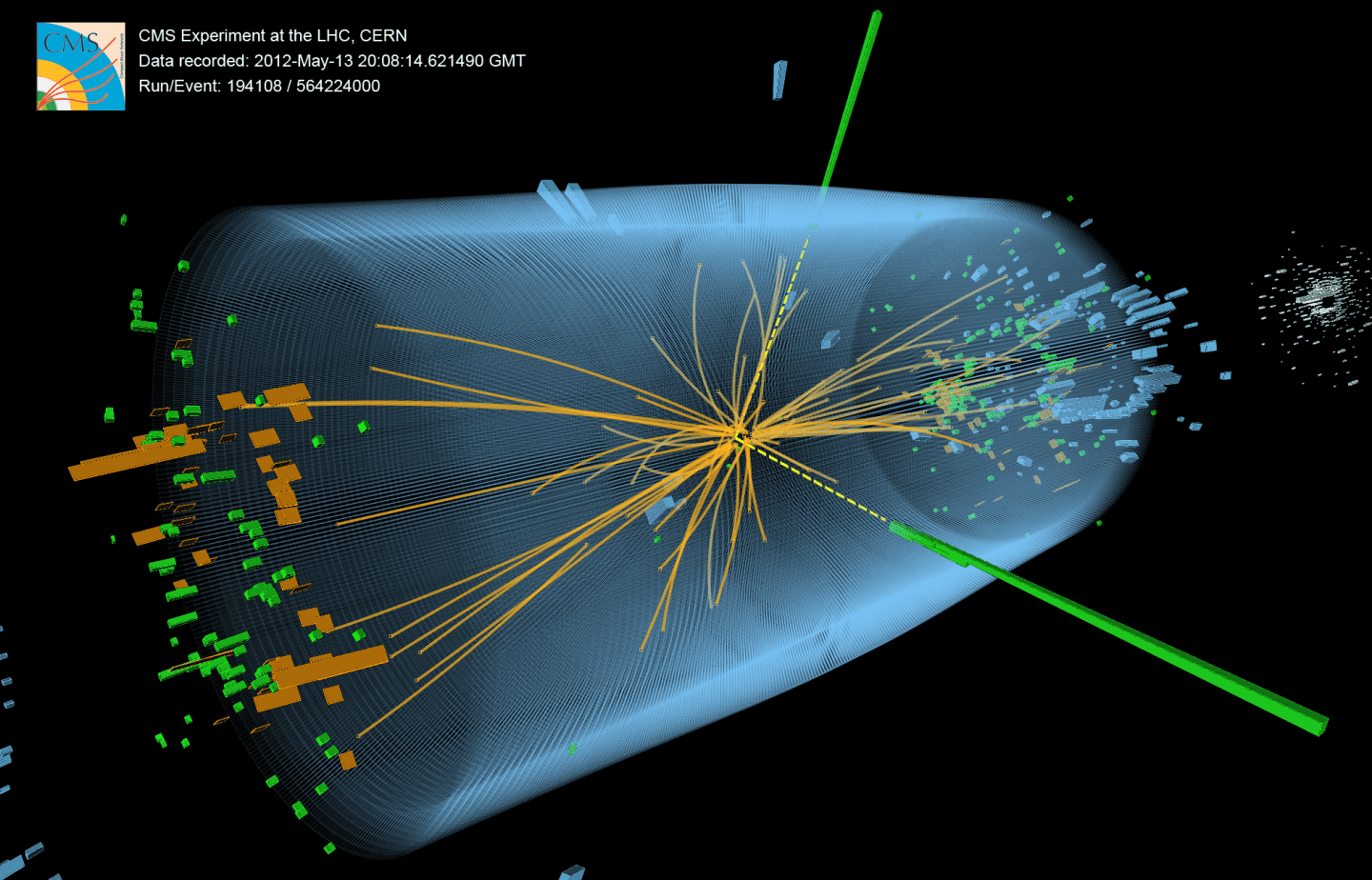It’s massive.
It’s 27 kilometers long and 100 meters underground.
It took thousands of people from over 100 countries 30 years to build.
It costs more than 5 billion dollars.
It’s the largest science instrument ever built by man.
It’s been said that it can open portals to other dimensions and even create black holes.
And it’s been turned on.
So what is it?
It’s called the Large Hadron Collider (LHC).

Built by the European Organization for Nuclear Research, better known as CERN, it’s the world’s biggest operational vacuum system and the largest and most powerful particle accelerator – a long circular tube comprised of special pipes that are as empty as interstellar space and colder than space itself.
In fact, the temperature inside those pipes is an insane -271.3°C —just a few degrees shy of the temperature where all molecular motion ceases: absolute zero.
Yet, it can generate a staggering temperature of 5 trillion degrees Celsius – hotter than a supernova explosion and 366,000 times hotter than the center of the sun.
It’s no wonder some believe it can create a black hole and blow up the world.
But what is it really?
It’s a massive particle accelerator.
Don’t worry; particle accelerators have been around since the 1930s.
They are used to produce energetic particles to explore what makes up the center of atoms, the structure of the atomic nucleus.
These accelerators can be shaped like rings, where particles zoom around in circles or in straight lines, where particles zip from one end to the other.
They work by using electric fields to push particles in one direction, creating more energy and making them move faster.
In theory, the length of an accelerator, such as a particle accelerator, is directly related to the energy and speed of the particles it can produce.
Longer accelerators allow for more acceleration, which means the particles can reach higher speeds. This is because the particles are accelerated multiple times as they travel through the length of the accelerator, gaining more speed with each pass.
At 27 kilometers long, the Large Hadron Collider accelerates protons to nearly the speed of light before smashing them together.

But why?
Protons are one of the smallest particles we know of today – second only to quarks and leptons (more in a bit).
To give you some perspective, a proton is about 100,000 times smaller than the atom it resides in.
Imagine a grain of sand typically around 0.5 to 2 millimeters in size. Now, consider that a proton is about 100,000 times smaller than that grain of sand. If a grain of sand were the size of Earth, a proton would be about the size of a small marble on that scale.
That’s not even the crazy part.
Inside the Large Hadron Collider, two high-energy particle beams carrying protons travel at close to the speed of light before they are made to collide. The beams travel in opposite directions in separate beam pipes inside a space the width of a human’s hair.
That hair strand might seem small, but a proton compared to the width of your hair is like a grain of salt compared to the entire Earth!
Smashing protons together that’s travelling near the speed of light is extremely hard – like firing two needles 10 kilometers apart with such precision that they meet halfway and split each other.
So how do they do that?

To ensure the protons stay on track, a 27km ring of superconducting magnets maintains magnetic fields, which help steer and focus these particles.

The electromagnets are built from special electric cable coils that operate in a superconducting state, efficiently conducting electricity without resistance or loss of energy. This requires chilling the magnets to – 271.3°C – a temperature colder than outer space.
Just prior to collision, another type of magnet is used to “squeeze” the particles closer together, increasing the chances of collisions.
This entire process takes an insane amount of energy, so everything has to be perfect, just like a rocket launch.
In fact, the Large Hadron Collider uses about 120 megawatts of power when operating—that’s enough to power a small city!
Of course, it would be silly to think they only shoot a couple of protons to make this all work.
Why risk shooting just one needle to hit another needle 10 km away? The chances of those needles hitting each other would be pretty slim.
And it is.
So how do they do it?
Well, as you likely guessed, they shoot more than one proton at a time – billions, actually.
On average, each beam contains 100 billion protons sent in opposite directions—that’s 100 billion protons vs. 100 billion protons!
But not all of these protons are fired at once.
They arrange these protons in bunches, with about 2,808 bunches per beam, each containing billions of protons.
With 2,808 bunches per beam, there are approximately 208,320 bunches circulating in the collider at any given time.
And guess how many actually collide per crossing?
Just 50-60 protons.
That’s why they do this over and over again—a whopping 30 million times…per second!
With nearly 3000 bunches, each with over 100 billion protons, the Large Hadron Collider is creating 1 billion collisions per second!
But why?
Is it to open another dimension? Is it to create a black hole? Is to bring in evil spirits?
Perhaps…
But that’s not technically and scientifically what it’s designed for.
It was designed to study what created the Universe – to understand what might have happened near the beginning of the Universe, when the Big Bang supposedly occurred.
How did the smallest of small create such an enormous amount of energy to create the Universe as we know it today?
Concerned About CERN?
I know what you’re thinking: if we succeed in replicating the Big Bang, the biggest explosion in the history of the Universe, wouldn’t that wipe us out?
Well, there’s no need to worry – yet.
Despite being designed to replicate the time closest to the Big Bang, when two protons collide in the Large Hadron Collider, the energy released is on the scale of a billionth of a joule.
This is similar to the kinetic energy of a flying mosquito.
In comparison, a lightning bolt releases about 5 billion joules of energy or about 1 million times more energy than a single proton-proton collision in the Large Hadron Collider.
However, scientists have discovered that when protons collide at incredibly fast speeds, they release so much energy that it can turn into physical mass.
If the energy is high enough, it can turn into mysterious or unknown particles—and that is what scientists are looking for.
You see, math is a very interesting thing that can predict and solve many unanswered questions.
For example, Albert Einstein’s theory of relativity, better known as E=mc2, wasn’t proven until decades after its first publication.
In 1869, Russian chemist Dmitri Mendeleev created a framework that evolved into the modern periodic table. But when he drew it up, he left placeholders for elements he knew existed but had yet to be identified. He even anticipated the characteristics of certain undiscovered elements, assigning them provisional names like “eka-aluminium” for an element resembling aluminum. Years later, eka-aluminium was identified as gallium. Despite some inconsistencies, his “missing elements” theory proved quite accurate.
So, just as we discovered the elements on the periodic table with math, could there be particles we have yet to discover that could change how we view the Universe?
The answer is yes.
The Standard Model
Think of dividing something over and over again until you get something that can’t be divided anymore.
These are called elementary particles – the most fundamental building blocks of matter and energy in the Universe.
You’ve heard of electrons and photons – these are elementary particles.
Just as chemists rely on the periodic table, physicists rely on the Standard Model for these elementary particles—a theory in particle physics that describes the fundamental particles and forces that make up the Universe.
 The Standard Model classifies particles into two broad categories: fermions and bosons.
The Standard Model classifies particles into two broad categories: fermions and bosons.
Fermions are the particles that make up matter. They include quarks (which make up protons and neutrons) and leptons (such as electrons), the smallest of the small as we know today.
In fact, quarks and leptons are so small that there is no evidence that they have any size at all. Weird, right?
However, physicists at Fermilab’s Tevatron and CERN’s LEP and LHC colliders have set a limit on the size of quarks and leptons: They must be smaller than about 0.001 times the size of a proton.
Bosons, on the other hand, are particles that mediate the forces between fermions. In simpler terms, they are the carriers of forces and energy in the Universe.
However, before 2012, the Standard Model predicted that there should be another particle – a particle that was likely present near the beginning of the Universe but has yet to be found.
They called this mystery particle the “God particle,” otherwise known as the Higgs boson.
The Higgs boson’s existence was necessary to explain how particles acquire mass – without its confirmation, the Standard Model would be incomplete.
Here is Nobel Prize winner Peter Higgs describing what it is.
https://x.com/NobelPrize/status/1779190652175011900
In simpler terms, this “God particle” is the reason why everything we feel exists.
To confirm that the Higgs boson exists, physicists needed to concentrate enough energy in one place to create it—such as smashing two protons together at nearly the speed of light.
That’s one of the primary reasons—at least, as they have publicly stated— that the Large Hadron Collider was created.
In 2012, after repeatedly smashing protons at the Large Hadron Collider, the Higgs boson was discovered.
But How?
This is where math plays a critical role – and why thousands of scientists were needed to confirm this.
You see, when the protons are smashed together, creating the special mystery God particles, they only exist briefly before turning back into normal particles.
This is why the Large Hadron Collider has some of the most advanced sensors and detectors ever built for particle physics research.
When these particles explode and fly outward towards the sensors, the sensors record exactly where these particles hit.

Working backward and using the most complex physics to reverse-engineer what happened at the moment of collision to confirm the mystery particle, physicists were able to detect a small blip.
It looks like this:

And yup, that’s it. This blip is what confirmed the presence of the Higgs boson.
Billions of dollars, 100 countries, and thousands of scientists culminated to create this blip in a chart.
If you really think you can understand advanced physics, feel free to learn more about this “blip” here.
What the Blip!?!
Surely, scientists wouldn’t have spent so much time and money just to create a blip in a chart.
Surely, they were at least trying to open portals or summon demons.
Well, despite a rather mundane discovery as it applies to real life, the by-product of the work done at CERN has actually generated a ton of real life applications.
These include cancer treatments, electric cars, medical imaging, and even the World Wide Web.
Perhaps, eventually, the discovery made using the Large Hadron Collider could propel our world into a new area of discovery. Perhaps it can help us better understand dark matter or even anti-gravity and zero-point energy.
And while there are skeptics about what the Large Hadron Collider can teach us, that’s not stopping scientists from advancing its research.
In fact, scientists are already looking to develop an even bigger collider in Europe – one that is 100km long and vapidly called the Future Circular Collider.
Guess who else is looking to build its own 100km collider?
That’s right, China.
“Construction of the world’s largest particle collider could begin in China in three years, although it must still win government approval and secure funding, a leading scientist said.
The 36 billion yuan (US$5 billion) Circular Electron Positron Collider (CEPC), also known as a Higgs factory, will take about 10 years to build and become the next global centre of particle physics, according to Wang Yifang, director of the Institute of High Energy Physics in Beijing.
By accelerating electrons and their antiparticles – positrons – in a 100km-long (62-mile) underground tunnel to extremely high energies and smashing them into each other, the CEPC will create millions of Higgs bosons and allow scientists to make new discoveries beyond the Standard Model – our existing best theory to describe the basic building blocks of the Universe.”
So, while billionaires like Elon Musk and Jeff Bezos are launching things into space, scientists around the world are looking to create the things that make space.
What will happen when we smash particles using higher energies than ever before?
A 100km collider could potentially reach collision energies of 100 tera-electron-volts, about six times the collision energy of the Large Hadron Collider (LHC), and equal to the collision energy created by supernova remnants, pulsars, and cosmic rays.
The question is, will this make a difference?
What do you think will happen? Will we create a black hole? Open another dimension? Create dark matter and harness unlimited energy?
The reason for explaining what the Large Hadron Collider is in this investment newsletter is to show you that there are a plethora of new technologies on the horizon that will change our understanding of the world.
This includes not just new discoveries with AI, but also discoveries using tools that allow us to see things so small that we can detect diseases with just a single breath.
Happy Hunting.
Seek the truth and be prepared,
Carlisle Kane













If you have seen some of the Satanic rituals preformed there, you would not give Cern any publicity.
5 billion could be spent better.
I understand that basic scientific research is very important and requires a lot of effort and expense to produce results.
However, priorities must be set when allocating funds.
These priorities should help make the lives of millions better, not primarily satisfy the curiosity of scientists.
For example, I managed to understand the topic of how to approach the creation of rational machines.
Here is proof of my competence: “Receptors cannot derive information about the events that led to changes in their respective states.”
Nevertheless, no one is in a hurry to support me in my desire to make the existence of Earth-type life more stable in the face of the irresistible forces of Nature and, at the same time, create a universal tool for processing information in accordance with its meaning.
Among other things, this tool can generate almost unlimited income.
Just one application of it for autonomous control of existing transportation means could generate at least 50,000,000 x $24,000 = $1,200,000,000,000 yearly.
Where 50,000,000 number of vehicles autonomously operated and $24,000 is yearly leasing fee.
Today there more than 2 billion vehicles on Global roads.
Looks like the US will also have one in by 2030 at Brookhaven National Laboratory in Upton, New York, will be home to the Electron-Ion Collider [EIC], which will probably find new applications in many areas for us all to benefit. No different than why we invest in space endeavours. Well worth it.